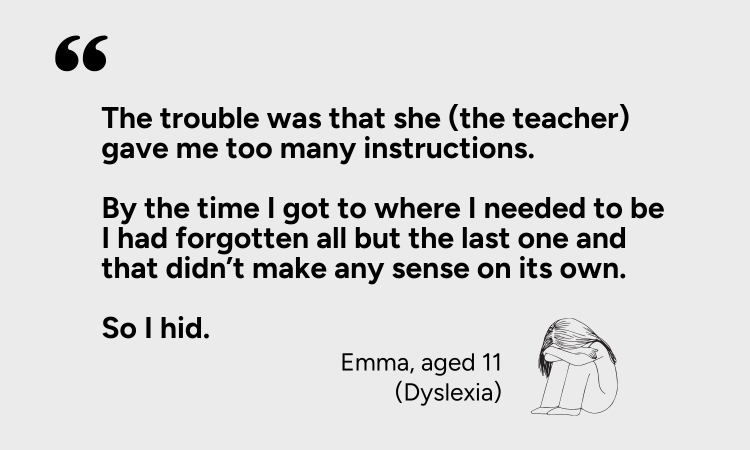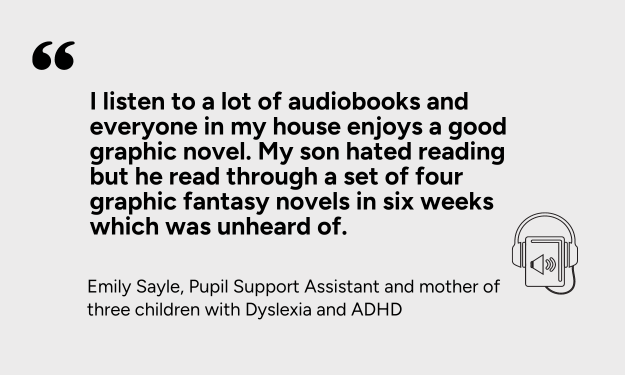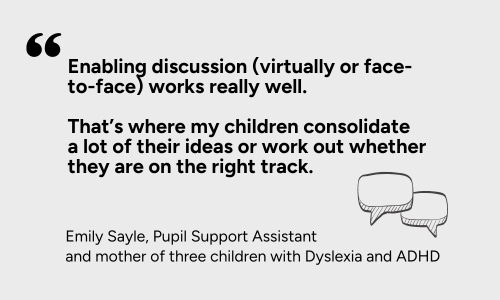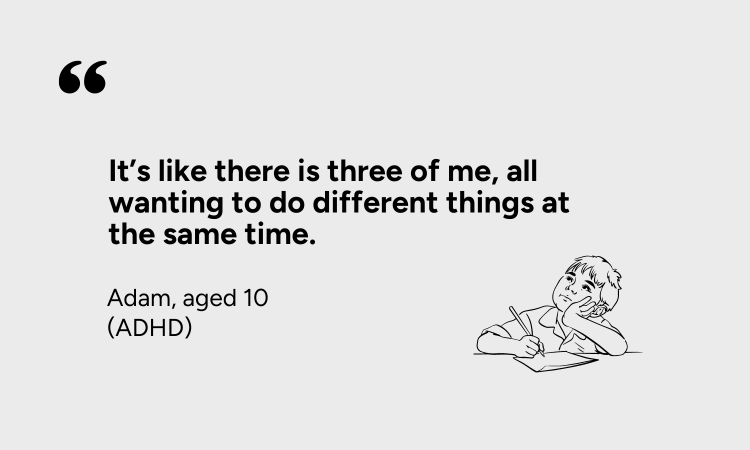ADHD and Dyslexia: How to Help Children Thrive in School
Imogen Barber
Although dyslexia and ADHD are two distinct conditions, the two frequently co-occur and can have a knock-on effect on one another. Between 18-42% of people with dyslexia also have ADHD. Conversely, dyslexia is also the most commonly co-occurring condition for people already diagnosed with ADHD.
However, the two conditions are often not diagnosed simultaneously and often the order in which they are identified frequently differs between boys and girls – impacting the support they will have access to. In this article, we’ll take a look at how to provide early intervention and support for children, as well as ways to nurture the positive skills and capabilities that both conditions can bring.
Article quick navigation links:
- Understanding similarities and differences
- Early intervention – a different story for girls and boys?
- Supporting both conditions at the same time
- Strategies to help children in school
- Celebrating the strengths of young people with ADHD and dyslexia
- Famous people with ADHD and dyslexia
Understanding similarities and differences between ADHD and dyslexia
Scientists still don’t fully understand the exact neurological mechanisms for either dyslexia or ADHD. Dyslexia, however, is generally categorized as a language-based disability (although some dyslexics read above their peers and struggle more with spelling and executive function). ADHD on the other hand is a neurodevelopmental disorder that makes it challenging for children to stay focused on a task, due to problems with attention.
Individuals with dyslexia have problems with phonemic awareness, in other words working with the smallest units of sound and matching these to written letters. They also struggle with verbal memory and verbal processing speed.

ADHD, on the other hand, is characterized by inattention, hyperactivity, and impulsivity and is often thought of as atypical activation in the regulatory systems in the frontal lobe. People tend to fall into three categories, those that display more inattentive symptoms, those who have problems with hyperactivity and impulsiveness and those that have a combination of the two. Boys in particular often get diagnosed earlier because they tend towards hyperactivity dimension;
Shared characteristics
- Attention; children with dyslexia and ADHD both struggle with attention. However for dyslexic thinkers, this is pretty much limited to reading and writing, whereas for ADHD it can apply to any task that doesn’t immediately capture their interest.
- Organisation and timekeeping; working memory deficits can be common to both dyslexia and ADHD, resulting in poor time-keeping and forgetfulness. Children may also struggle with general organisation skills.
- Spatial awareness and motor skills; tasks co-coordinating fingers can be a challenge for some learners with ADHD and some children with dyslexia. For example, tasks coordinating index fingers on both right and left hand (bi-manual coordination) and one finger and the adjacent fingers on the same hand (uni-manual coordination.) (Marchand-Krynski et al 2017)
- Reading; children with ADHD and/or dyslexia might misread individual words, skip over or miss out chunks of text, or lose their place on the page. Individuals with ADHD may particularly struggle to retain and connect meaning from one part of the text to another.
- Writing; children with both conditions may struggle with written work. However, for children with ADHD, the problems will focus more on organising and structuring their work, whereas children with dyslexia will have specific problems with spelling and grammar. Both may have problems with keeping their handwriting neat and tidy.
Early intervention – a different story for boys and girls?
Often whichever condition is the more pronounced will be the one that is diagnosed first. However, there can be noticeable gender-based differences. As the impulsive side of ADHD is more common in boys it becomes more obvious when they are younger and can’t sit still. (Stibbe et al 2020). In extreme cases where they may be simply unable to sit down before they can read a book or any printed material, it makes sense to tackle their ADHD first.
Girls tend towards the inattentive side of ADHD which means they are more likely to be diagnosed with dyslexia, while ADHD can go unnoticed. They are often the ones sat daydreaming in the back of the class rather than displaying the more obviously outward signs of ADHD.
Supporting both conditions at the same time
If one condition is diagnosed without the other, the effectiveness of early intervention might be impacted. In a recent webinar for ADDitude Dr Cheryl Chase made the following observations;
- You cannot address just one condition – they must be treated simultaneously
- Both should be treated separately as they both have separate mechanisms
- Dyslexia might impact the effectiveness of treatments for ADHD, particularly if they involve a lot of reading e.g. word-heavy checklists
- ADHD might mean it takes longer for normal dyslexic teaching to have an impact, so sessions may need to be tapered down or shortened accordingly
- Treating ADHD will not cure a young person of dyslexia
Getting a dyslexia diagnosis might be more straightforward than getting an ADHD diagnosis, so specialist literacy support teachers should be aware of how to adapt sessions. This might include shorter session duration, or switching up format (or the reading topic) if children seem to be readily overwhelmed or distracted. The Dyslexia Action Literacy Programme (or DALP) is a literacy toolkit specifically designed to put learners at the centre of their experience and has been used successfully with children with speech and language difficulties, ADHD, autism, and dyspraxia as well as dyslexia.
We’ve also put together some further strategies below.
Strategies to help children in school
Reading and focus
- Switch things up; when doing small group or one-to-one work specialist literacy teachers might want to chunk sessions into 10-15 minute activities and make sure they are interspersed with more physical activity, such as playing a game.
Pupil support assistant, Emily Sayle, is more qualified than most to give her perspective on the two conditions. Not only does she support learners with co-occurring difficulties day-to-day, but also has two children with ADHD and dyslexia and one with ADHD, dyslexia and autism. Emily herself also has both conditions. Emily advises breaking up the rigid format of lessons to get everyone moving.

- Encourage self-directed learning; help pupils retain their focus by making them active and in charge of the learning sequence, so they don’t feel restricted or rendered passive by lots of instructions.
- Take regular breaks; children with both ADHD and dyslexia need more regular breaks in between activities, particularly those that involve reading written instructions
- Tap into hyperfocus; finding things that pupils are interested in might tap into hyperfocus, although the extent to which this can be maintained without encountering reading fatigue should be taken into account

- Audiobooks; switching from text to video or audio input can help reduce reading fatigue and help maintain focus.
- Sensory supports; such as fidget tools or wobble chairs can also help during reading activities. Emily tells us how she uses these on a day-to-day basis;

- Teach meta-cognition; helping pupils identify better learning strategies can help them approach reading and comprehension more effectively. A common example might be encouraging a deeper understanding of certain keywords in questions, and asking pupils to highlight such words before they dive into the answer, particularly when it comes to maths.
- Coloured strips and bookmarks; can help dyslexic children keep their place when reading.
- Using technology; any speech-to-text technology can help as can setting up virtual discussion groups, or providing digital notetaking apps for older children.

Organisation
- Pictorial checklists, colour-coded timetables or short to-do lists; while anything too wordy might add to reading fatigue, short checklists and use of images, or colour-coded timetables can act as useful prompts.
- Locker organisers, places for keys, whiteboards, daily A3 planners; both dyslexia and ADHD can have a chaotic element and it can be useful to have designated places for things as well as techniques to help children remember things such as colour-coded homework diaries.
- Keep duplicates or use a folder system; keeping duplicate textbooks, personal IT equipment, pens etc. at home in case things get lost. Below Emily told us the technique that worked well for each of her children.

Behaviour
- Seating systems; seating pupils next to less distractible students and at the front of the class with an uninterrupted view of the teacher.
- Using a token system; rewarding pupils when they remember to do things like put their hand up.
Boosting self-confidence
- Provide opportunities to be creative; follow the interest of the young person to help them maintain focus and explore their imagination. Leading charity ADDitude has some great ideas for accessible and exciting storybooks for children who also have dyslexia.
- Emphasise difference – not weakness, help pupils to see what they are good at. For people with ADHD and dyslexia this might be activities, such as storytelling, art or graphics or creative problem-solving and expression; as Emily puts it “I can use a hundred different ways to explain the same thing”. Bringing neurodiverse role models into school and having a whole-school approach to embracing neurodiversity can also help challenge negative self-beliefs.
- Improvisation; working on improvisation in drama and music often plays to the strengths of individuals with both ADHD and dyslexia.
- Encourage musical instruments; learning to play an instrument may have multi-fold benefits, helping with listening skills, memory, concentration and self-confidence for children with both dyslexia and ADHD.
Managing anxiety
- Cognitive behavioural therapy; has been shown to have positive benefits for some children with ADHD.
- Get moving; not only can exercise improve well-being but also help to absorb excess energy, particularly for children who have a greater tendency towards hyperactivity.
- Meditation; some studies suggest meditation and mindfulness may work for young adolescents with ADHD, although if it is to be effective it must be practiced at home not just at school.
Celebrating the strengths of young people with ADHD and dyslexia
Children with dyslexia might show above-average creativity, curiosity, imagination and non-verbal skills. As with other neurodivergent conditions, strengths and weaknesses are not rigidly defined; some dyslexic children may be exceptionally gifted with oral vocabulary, others may even read silently at levels above their peers.
Children with ADHD may also be highly creative and more open to trying new experiences. The ability to engage in hyperfocus can help them become passionate subject-matter experts relatively quickly, on topics that they find naturally engaging.
Famous people with ADHD and dyslexia
There are plenty of people from all walks of life who are living with both conditions. It’s also worth pointing out that both ADHD and dyslexia also have greater occurrence in entrepreneurs than in the general population. The energy, creativity, and resilience that emerge either out of necessity or natural ability are highly valuable attributes in the rapidly changing dynamics of the modern workplace.
Notable figures include:
- Bill Gates
- Ingvar Kamprad (founder of Ikea)
- John T. Chambers (CEO of Cisco)
- Zoe Saldana
- McKenna Hallem (model)
- Mark Ruffalo
- Whoopi Goldberg
- Albert Einstein
Final thoughts
ADHD and dyslexia frequently co-occur and can create more complex problems for children. It is important therefore, that both specialist literacy teachers and practitioners as well as classroom teachers and TAs have an understanding of how they can co-occur and what to look out for. If specialist literacy teachers suspect ADHD might also be at play, they should share this knowledge with class teachers and SENCOs who can make joint decisions about the best next steps and how parents should be involved. A joint strategy can then be put in place to help support the pupil.
Both dyslexia and ADHD can lead to low self-esteem and children often carry beliefs that they are “stupid” or “slow”. Getting the right support to these individuals can help raise their confidence – but there’s also a great need to educate the wider school community to recognise the amazing benefits having an alternatively wired brain can bring.
————————————————————————————————————————–
Dyslexia Action offers short CPD courses including units covering co-occuring difficulties, for teachers, teaching assistants and specialist practitioners who support children with literacy difficulties. If you are interested in becoming a specialist literacy teacher, practitioner or assessor, we also offer both Level 5 and Level 7 courses – including training on our unique Dyslexia Action Literacy Programme which has been successfully used to support children with a range of additional learning needs.






